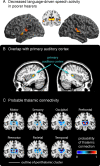Hearing loss in older adults affects neural systems supporting speech comprehension
- PMID: 21880924
- PMCID: PMC3175595
- DOI: 10.1523/JNEUROSCI.2559-11.2011
Hearing loss in older adults affects neural systems supporting speech comprehension
Abstract
Hearing loss is one of the most common complaints in adults over the age of 60 and a major contributor to difficulties in speech comprehension. To examine the effects of hearing ability on the neural processes supporting spoken language processing in humans, we used functional magnetic resonance imaging to monitor brain activity while older adults with age-normal hearing listened to sentences that varied in their linguistic demands. Individual differences in hearing ability predicted the degree of language-driven neural recruitment during auditory sentence comprehension in bilateral superior temporal gyri (including primary auditory cortex), thalamus, and brainstem. In a second experiment, we examined the relationship of hearing ability to cortical structural integrity using voxel-based morphometry, demonstrating a significant linear relationship between hearing ability and gray matter volume in primary auditory cortex. Together, these results suggest that even moderate declines in peripheral auditory acuity lead to a systematic downregulation of neural activity during the processing of higher-level aspects of speech, and may also contribute to loss of gray matter volume in primary auditory cortex. More generally, these findings support a resource-allocation framework in which individual differences in sensory ability help define the degree to which brain regions are recruited in service of a particular task.
Figures



Similar articles
-
Neural processing during older adults' comprehension of spoken sentences: age differences in resource allocation and connectivity.Cereb Cortex. 2010 Apr;20(4):773-82. doi: 10.1093/cercor/bhp142. Epub 2009 Aug 7. Cereb Cortex. 2010. PMID: 19666829 Free PMC article.
-
Differences in Hearing Acuity among "Normal-Hearing" Young Adults Modulate the Neural Basis for Speech Comprehension.eNeuro. 2018 Jun 8;5(3):ENEURO.0263-17.2018. doi: 10.1523/ENEURO.0263-17.2018. eCollection 2018 May-Jun. eNeuro. 2018. PMID: 29911176 Free PMC article.
-
Afferent-efferent connectivity between auditory brainstem and cortex accounts for poorer speech-in-noise comprehension in older adults.Hear Res. 2019 Oct;382:107795. doi: 10.1016/j.heares.2019.107795. Epub 2019 Aug 27. Hear Res. 2019. PMID: 31479953 Free PMC article.
-
Speech comprehension aided by multiple modalities: behavioural and neural interactions.Neuropsychologia. 2012 Apr;50(5):762-76. doi: 10.1016/j.neuropsychologia.2012.01.010. Epub 2012 Jan 17. Neuropsychologia. 2012. PMID: 22266262 Free PMC article.
-
The Neural Consequences of Age-Related Hearing Loss.Trends Neurosci. 2016 Jul;39(7):486-497. doi: 10.1016/j.tins.2016.05.001. Epub 2016 Jun 1. Trends Neurosci. 2016. PMID: 27262177 Free PMC article. Review.
Cited by
-
Hippocampal atrophy is associated with hearing loss in cognitively normal adults.Front Neurosci. 2023 Oct 24;17:1276883. doi: 10.3389/fnins.2023.1276883. eCollection 2023. Front Neurosci. 2023. PMID: 37942139 Free PMC article.
-
Relationship between Auditory and Cognitive Abilities in Older Adults.PLoS One. 2015 Aug 3;10(8):e0134330. doi: 10.1371/journal.pone.0134330. eCollection 2015. PLoS One. 2015. PMID: 26237423 Free PMC article.
-
Editorial: Hearing Loss and Cognitive Disorders.Front Neurosci. 2022 May 16;16:902405. doi: 10.3389/fnins.2022.902405. eCollection 2022. Front Neurosci. 2022. PMID: 35651627 Free PMC article. No abstract available.
-
Hearing loss and dementia - who is listening?Aging Ment Health. 2014;18(6):671-3. doi: 10.1080/13607863.2014.915924. Aging Ment Health. 2014. PMID: 24875093 Free PMC article. No abstract available.
-
At the interface of sensory and motor dysfunctions and Alzheimer's disease.Alzheimers Dement. 2015 Jan;11(1):70-98. doi: 10.1016/j.jalz.2014.04.514. Epub 2014 Jul 9. Alzheimers Dement. 2015. PMID: 25022540 Free PMC article. Review.
References
-
- Adank P, Janse E. Comprehension of a novel accent by young and older listeners. Psychol Aging. 2010;25:736–740. - PubMed
-
- Ashburner J, Friston KJ. Unified segmentation. Neuroimage. 2005;26:839–851. - PubMed
-
- Behrens TEJ, Johansen-Berg H, Woolrich MW, Smith SM, Wheeler-Kingshott CAM, Boulby PA, Barker GJ, Sillery EL, Sheehan K, Ciccarelli O, Thompson AJ, Brady JM, Matthews PM. Non-invasive mapping of connections between human thalamus and cortex using diffusion imaging. Nat Neurosci. 2003;6:750–757. - PubMed
Publication types
MeSH terms
Substances
Grants and funding
- AG15116/AG/NIA NIH HHS/United States
- AG32953/AG/NIA NIH HHS/United States
- P50 NS053488/NS/NINDS NIH HHS/United States
- AG17586/AG/NIA NIH HHS/United States
- NS53488/NS/NINDS NIH HHS/United States
- NS54575/NS/NINDS NIH HHS/United States
- AG019714/AG/NIA NIH HHS/United States
- R01 NS044266/NS/NINDS NIH HHS/United States
- P01 AG032953/AG/NIA NIH HHS/United States
- R01 AG015116/AG/NIA NIH HHS/United States
- R01 AG019714/AG/NIA NIH HHS/United States
- T32 NS054575/NS/NINDS NIH HHS/United States
- NS44266/NS/NINDS NIH HHS/United States
- P01 AG017586/AG/NIA NIH HHS/United States
LinkOut - more resources
Full Text Sources
Other Literature Sources
